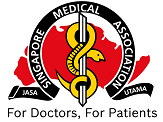Mainstream end-tidal carbon dioxide monitoring in ventilated neonates
Share this Article
Singapore Med J 2008; 49(3):199-203
Mainstream end-tidal carbon dioxide monitoring in ventilated neonates
×
![]()
Predictors of newborn admission after labour induction at term: Bishop score, pre-induction ultrasonography and clinical risk factors
Share this Article
Singapore Med J 2008; 49(3):193-8
Predictors of newborn admission after labour induction at term: Bishop score, pre-induction ultrasonography and clinical risk factors
×
![]()
Predictors for caesarean delivery and neonatal admission after trial of labour in women with one previous lower segment caesarean scar
Share this Article
Singapore Med J 2008; 49(3):188-92
Predictors for caesarean delivery and neonatal admission after trial of labour in women with one previous lower segment caesarean scar
×
![]()
Inpatient paediatric use of intravenous immunoglobulin at an academic medical centre
Share this Article
Singapore Med J 2008; 49(2):147-9
Inpatient paediatric use of intravenous immunoglobulin at an academic medical centre
×
![]()
Digital imaging by parents: an aid to the diagnosis of inguinal hernia in infants and children
Share this Article
Singapore Med J 2008; 49(2):145-6
Digital imaging by parents: an aid to the diagnosis of inguinal hernia in infants and children
×
![]()
Early outcome of congenital diaphragmatic hernia in a Malaysian tertiary centre
Share this Article
Singapore Med J 2008; 49(2):142-4
Early outcome of congenital diaphragmatic hernia in a Malaysian tertiary centre
×
![]()
Antihyperglycaemic and antihyperlipidaemic effects of Nymphaea stellata in alloxan-induced diabetic rats
Share this Article
Singapore Med J 2008; 49(2):137-41
Antihyperglycaemic and antihyperlipidaemic effects of Nymphaea stellata in alloxan-induced diabetic rats
×
![]()
Blood lipid peroxidation (superoxide dismutase, malondialdehyde, glutathione) levels in Egyptian type 2 diabetic patients
Share this Article
Singapore Med J 2008; 49(2):129-36
Blood lipid peroxidation (superoxide dismutase, malondialdehyde, glutathione) levels in Egyptian type 2 diabetic patients
×
![]()
Independent predictors of cardiac parasympathetic dysfunction in type 2 diabetes mellitus
Share this Article
Singapore Med J 2008; 49(2):121-8
Independent predictors of cardiac parasympathetic dysfunction in type 2 diabetes mellitus
×
![]()
Comparison of serum F2 isoprostane levels in diabetic patients and diabetic patients infected with Burkholderia pseudomallei
Share this Article
Singapore Med J 2008; 49(2):117-20
Comparison of serum F2 isoprostane levels in diabetic patients and diabetic patients infected with Burkholderia pseudomallei
×
![]()


